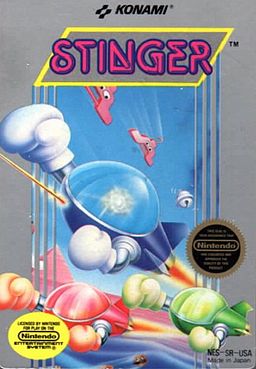- Stinger (video game)
-
For other uses, see Stinger (disambiguation).
Stinger
(Moero! Twinbee: Cinnamon Hakushi wo Sukue)
Front cover of the North American NES version.Developer(s) Konami Publisher(s) Konami Platform(s) Family Computer Disk System, Nintendo Entertainment System, I-revo, Virtual Console Release date(s) Disk System version
- JP November 21, 1986
I-revo
- JP April 14, 2006
- JP July 27, 2010
Genre(s) Shoot 'em up Mode(s) 1 or 2-player cooperative (3-player in the Japanese version) Media/distribution Disk System disk card, cartridge Stinger is a vertical/side-scrolling shoot-'em-up game released by Konami for the Nintendo Entertainment System in 1987. It is the North American localization of Moero! TwinBee: Cinnamon Hakushi wo Sukue! (もえろツインビー シナモン博士を救え! Burn! TwinBee: The Rescue of Dr. Cinnamon), the second game in the TwinBee series, which was originally released in Japan for the Family Computer Disk System expansion in 1986 and later re-released as a standard Famicom cartridge in 1993. Moero! TwinBee was the first of two TwinBee sequels released for the Famicom, followed by TwinBee 3 in 1989, which was released only in Japan. A few changes were made to the NES version, Stinger, from its Famicom counterpart.
Contents
Plot
According to the American version's back-story, a race of alien beings from the distant Planet Attackon located at the Ergo Galaxy have kidnapped Professor Einstein J. Cinnamon, a brilliant scientist who has invented bio-nuclear sweetener. The Attackons want to use the Professor's sweetener formula to turn the Earth into a giant ball of cotton-candy. The player takes the role of a pilot controlling the "Stinger", a spacecraft built by Dr. Cinnamon, in order to rescue the scientist.[1][2]
Gameplay
Much like the original TwinBee, Stinger can be played by up to two players simultaneously (three players in the Japanese versions). Unlike the original TwinBee, which only featured vertical-scrolling stages, Stinger adds side-scrolling stages to the mix as well. There are seven stages in the game. Stage 1, 3, and 7 are side-scrolling stages, while the rest are vertical-scrolling stages. The controls remain the same between the two styles of gameplay, with the only difference being that in the side-scrolling segments, the A button shoots hearts over the ship instead of dropping bombs into the ground like the vertical-scrolling segments, which helps the player keep the power-up bells afloat in the side-scrolling stages.
The player's primary power-up items are once again bells that uncovered by shooting floating clouds throughout the stages. There are six types of bells in this installment: the regular yellow bells give the player bonus points as usual, the blue bells increases the ship's speed; the white bell upgrades the player's gun into a twin cannon; the pink bell gives the player a laser beam cannon; the flashing pink/white bell gives the player's ship mirror options for added firepower; and the flashing blue/white bell will surround the player's ship with a barrier for extra protection from enemy fire. Some power-ups are mutually exclusive, such as the white and pink bells, are mutually exclusive. Other power-ups can be obtained by destroying ground enemies such as a moon item and star item which gives the player's ship a three-way shot and a five-way shot respectively. If two players are playing the game, they can align their ship together to turn their gun into a ripple laser.
Localization
The Japanese version of the game, Moero!! TwinBee, features a different back-story game, establishing it to be set 100 years after the events of the original TwinBee. The main characters were actually the grandchildren of the original TwinBee and WinBee pilots, while the antagonist was originally named Gattlantis, who is the grandchild of King Spice (the antagonist in the original TwinBee). The presence of Dr. Cinnamon a century after the original game is explained due to the fact that he was placed on cryogenic sleep after the events of the original game. The Japanese version featured more dialogue, as well as a scene at the opening and ending depicting the pilots of TwinBee, WinBee, and GwinBee.
The Japanese version also allowed for up to three players instead of just two by connecting an additional controller into the Famicom's expansion port (in the US version, WinBee was removed from the game and GwinBee was made into the Player 2 ship in her place). Another difference is a choice between two difficulty settings: Normal and Hard. In the American version, there's no difficulty option, but the player can replay the game on a harder difficulty after completing it once. In the Japanese cartridge version, a third easier setting was added as well.
References
External links
- Stinger guide at StrategyWiki
TwinBee series Arcade games TwinBee • Detana!! TwinBee • TwinBee Yahho!Console games Stinger • TwinBee 3 • Pop'n TwinBee (Game Boy) • Pop'n TwinBee (SNES)Spinoffs Rainbow Bell Adventures • Taisen Puzzle Dama • TwinBee RPG • Twinbee PARADISE in Donburishima • TwinBee DungeonPachislot TwinBee JG PachisuroList of TwinBee mediaCategories:- 1986 video games
- Famicom Disk System games
- Nintendo Entertainment System games
- TwinBee games
- Video game sequels
- Virtual Console games
Wikimedia Foundation. 2010.
